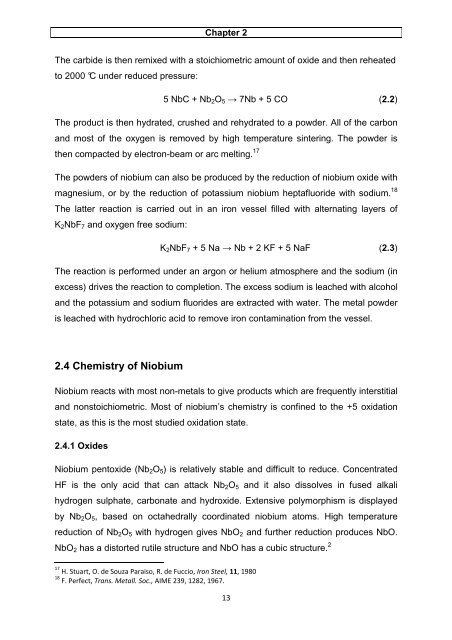A solution and solid state study of niobium complexes University of ...
A solution and solid state study of niobium complexes University of ...
A solution and solid state study of niobium complexes University of ...
You also want an ePaper? Increase the reach of your titles
YUMPU automatically turns print PDFs into web optimized ePapers that Google loves.
Chapter 2<br />
The carbide is then remixed with a stoichiometric amount <strong>of</strong> oxide <strong>and</strong> then reheated<br />
to 2000 °C under reduced pressure:<br />
5 NbC + Nb2O5 → 7Nb + 5 CO (2.2)<br />
The product is then hydrated, crushed <strong>and</strong> rehydrated to a powder. All <strong>of</strong> the carbon<br />
<strong>and</strong> most <strong>of</strong> the oxygen is removed by high temperature sintering. The powder is<br />
then compacted by electron-beam or arc melting. 17<br />
The powders <strong>of</strong> <strong>niobium</strong> can also be produced by the reduction <strong>of</strong> <strong>niobium</strong> oxide with<br />
magnesium, or by the reduction <strong>of</strong> potassium <strong>niobium</strong> heptafluoride with sodium. 18<br />
The latter reaction is carried out in an iron vessel filled with alternating layers <strong>of</strong><br />
K2NbF7 <strong>and</strong> oxygen free sodium:<br />
K2NbF7 + 5 Na → Nb + 2 KF + 5 NaF (2.3)<br />
The reaction is performed under an argon or helium atmosphere <strong>and</strong> the sodium (in<br />
excess) drives the reaction to completion. The excess sodium is leached with alcohol<br />
<strong>and</strong> the potassium <strong>and</strong> sodium fluorides are extracted with water. The metal powder<br />
is leached with hydrochloric acid to remove iron contamination from the vessel.<br />
2.4 Chemistry <strong>of</strong> Niobium<br />
Niobium reacts with most non-metals to give products which are frequently interstitial<br />
<strong>and</strong> nonstoichiometric. Most <strong>of</strong> <strong>niobium</strong>’s chemistry is confined to the +5 oxidation<br />
<strong>state</strong>, as this is the most studied oxidation <strong>state</strong>.<br />
2.4.1 Oxides<br />
Niobium pentoxide (Nb2O5) is relatively stable <strong>and</strong> difficult to reduce. Concentrated<br />
HF is the only acid that can attack Nb2O5 <strong>and</strong> it also dissolves in fused alkali<br />
hydrogen sulphate, carbonate <strong>and</strong> hydroxide. Extensive polymorphism is displayed<br />
by Nb2O5, based on octahedrally coordinated <strong>niobium</strong> atoms. High temperature<br />
reduction <strong>of</strong> Nb2O5 with hydrogen gives NbO2 <strong>and</strong> further reduction produces NbO.<br />
NbO2 has a distorted rutile structure <strong>and</strong> NbO has a cubic structure. 2<br />
17 H. Stuart, O. de Souza Paraiso, R. de Fuccio, Iron Steel, 11, 1980<br />
18 F. Perfect, Trans. Metall. Soc., AIME 239, 1282, 1967.<br />
13
















